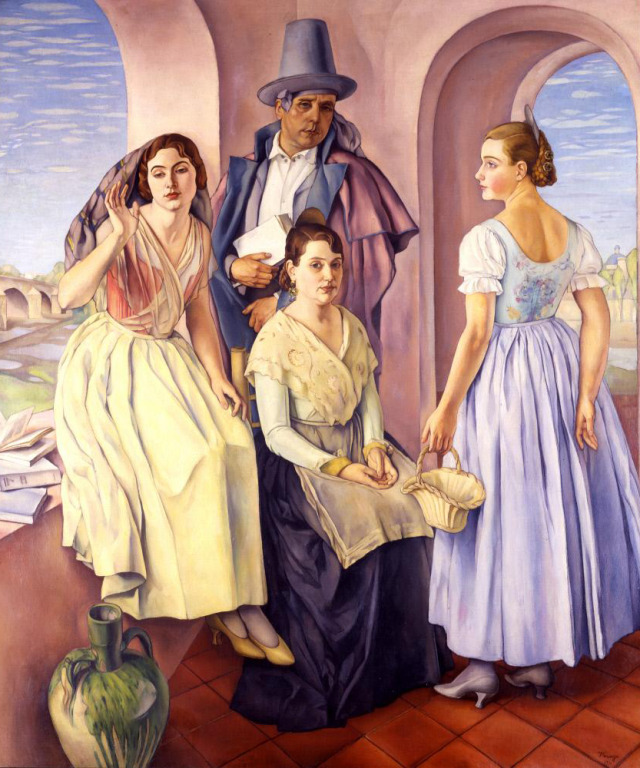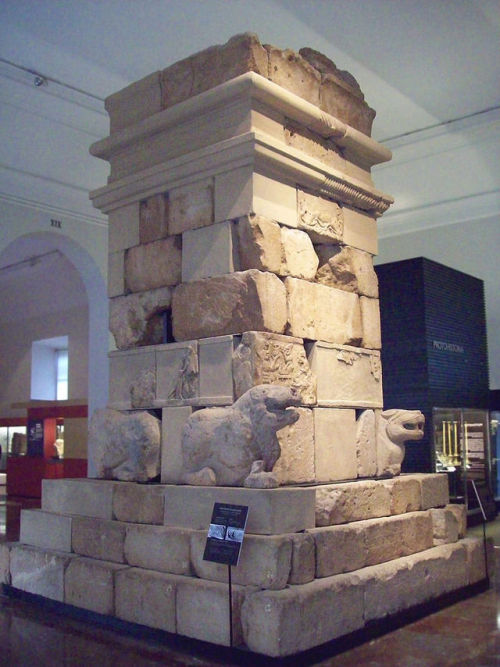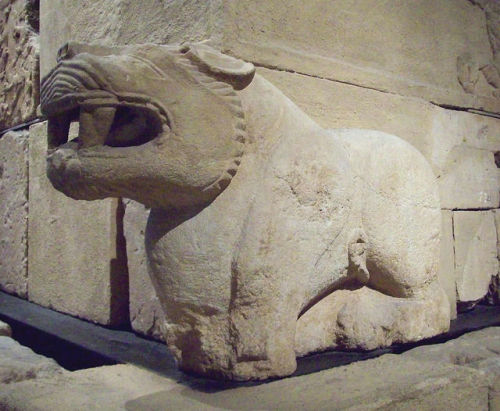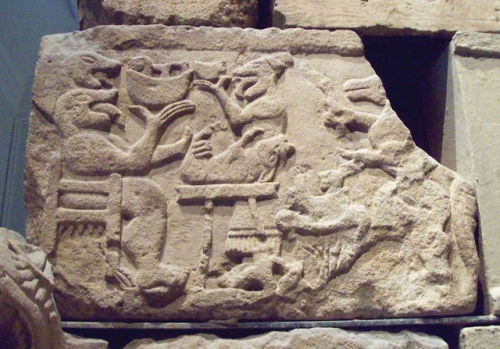#iberia

Scipio Africanus Freeing Massiva
Laurence Alma-Tadema [English. 1836 - 1912]
The Baths of Caracalla. 1899
-
In this specific painting, the scene depicts a reconstruction of the baths of the Roman Emperor Caracalla (176-217), which was imagined by Alma Tadema, and can still be found in Rome. His paintings were also based on his archaeological photographs and travels.
Lawrence Alma Tadema’s work was inspired by the civilizations of Greek, Rome and Ancient Egypt. He imagined the daily lives of these civilizations with their architectural ruins and came up with detailed compositions with exact accuracy.
Post link
Master of Affligem [Netherlandish. c. 1480 - c.1520]
Philip the Fair and Joan the Mad. c. 1495 - 1506
Maximilian I was supported in his struggle against France by England and Spain; in the latter case, the alliance was to be consolidated with a marriage. Although the widower Maximilian initially wanted to marry a Spanish princess himself, the royal house of Spain expressed a preference for the younger generation. In 1496 there was a double wedding: the children of Ferdinand and Isabella, Joan (Juana) of Castile and Aragon and her brother Don John (Juan), Prince of Asturias, were married to Maximilian’s children Philip and Margaret of Austria.
The marriages were thus not part of some cleverly conceived Habsburg strategy for acquiring the Spanish throne but, rather, a means of strengthening an alliance: the Austrians and the Spanish were to join forces in order to drive the French out of Italy and each take a share of the peninsula for themselves. However, the double wedding was followed by a sequence of strokes of good fortune that favoured the Habsburg cause: not only did Margaret’s new husband Don John die but so did all the other Spanish royal heirs, putting Joanna and her husband Philip first in line for the throne. In 1500, furthermore, they consolidated their claim to the succession by producing a son, the future Emperor Charles V, so that when Philip became King of Castile in 1504, Spain and all its possessions fell into Habsburg hands.
Only a few years later, however, Philip died, after which Joanna is said to have lost her mind – thus going down into history as Joanna the Mad – and was in any case not capable of governing. In 1506 her young son Charles was named as Philip’s successor; his grandfather Maximilian took measures to guarantee that the young boy would indeed one day accede to the throne. So it was that in 1516, as a result of a sequence of accidents, Charles became king in Spain, Naples and Sicily, and the Spanish colonies.- Read more on habsburger.net.
Post link
Paul Delaroche [French. 1797 - 1856]
Central portion of “L'Hémicycle des Beaux-arts” c.1841-42
-
The center figure with the laurel wreaths is an allegory of the arts, the woman in green is an allegory of medieval art, the woman in red sitting next to her is an allegory of ancient Greek art, directly across from her is a male figure that is an allegory of ancient Roman art, and next to him is a woman in red who is an allegory of the Renaissance. The other figures from left to right are: Germain Pilon, Pierre Puget, Giambologna, Ictinos, Apelle, Phidias, Philibert Delorme, Baldassarre Peruzzi and Erwin von Steinbach.
Post link

José Pinazo Martínez [Spanish. 1879 - 1933]
Nosotros. 1930
Mausoleum of Pozo Moro
Pozo Moro, Iberia, Spain
6th century BCE
10 m. high
The Mausoleum was found in pieces in an Iberian necropolis, strewn over a 12 x 12 m. The Mausoleum, which was erected by an Iberian king around 500 BCE, is the oldest known Iberian grave monument. The find spots of the rectangular blocks enabled an accurate reconstruction of the structure, which must have been about 10 metres high and have stood atop a three-level square pedestal 3.65 m wide. Four stone lions stood on the corners of the mausoleum, whose walls were decorated with reliefs depicting deities. These sculptures belong to the orientalising phase of Iberian art and are heavily influenced by Hittite and Syrian art
Post link
Hamilcar Barca or Barcas (ca. 275 BC – 228 BC) was a Carthaginian general and statesman, leader of the Barcid family, and father of Hannibal, Hasdrubal and Mago. He allegedly founded the city of Barcino (currently named Barcelona) while he was on Hispania. In eight years by force of arms and diplomacy Hamilcar secured an extensive territory in Hispania, but his premature death in battle of Ilici (228 BC) denied Carthage a complete conquest.
Post link
Mapa histórico y geográfico de los reinos de la península ibérica, en el Atlas historique de Henri Abraham Chatelain (1705 a 1739).
Post link

ACCADDE OGGI
Il 17 marzo del 45 a.C. ci fu la battaglia presso le pianure di Munda, l'ultimo scontro di rilievo della guerra civile in Iberia e che vide contrapposti sul campo di battaglia Giulio Cesare contro Gneo Pompeo e Tito Labieno, suo ex legato in Gallia.
Il resoconto della battaglia ci viene fornito in modo dettagliato da Cassio Dione e dal Bellum Hispaniense (un'opera letteraria il cui autore, probabilmente un comandante di Cesare, è sconosciuto).
“L'ordine di battaglia constava di 13 aquile, che erano protette ai lati dalla cavalleria, con 6 mila uomini di fanteria leggera; si aggiungevano inoltre quasi altrettanti ausiliari. Le nostre forze consistevano in 80 coorti e 8 mila cavalieri” (Bell. Hisp., XXX, 1).
L'esercito di Pompeo era accampato su una piccola collina, posizione sfavorevole ad un eventuale attacco di Cesare: “Sebbene i nostri fossero superiori per valore, gli avversari si difendevano disperatamente sulla posizione superiore e c'era da entrambi i lati un forte rumore e un fitto tiro di proiettili, così che i nostri quasi disperavano della vittoria” (Ivi, XXXI, 1).
“Cesare e Pompeo, vedendo dai loro cavalli a dalle alture questo spettacolo, non sapevano se dovevano sperare o temere. Nel vedere la battaglia dall'esito incerto, saltarono giù dai loro cavalli e si gettarono nella mischia” (Cassio Dione, XLIII, 37, 3-4).
Vista la progressione di Cesare sull'ala destra del suo schieramento, Pompeo tolse una legione dal suo fianco destro per poter meglio fronteggiare l'avanzata di Cesare, commettendo un grave errore: infatti la cavalleria di Cesare attaccò in forze il lato destro di Pompeo, mentre la cavalleria del re di Mauretania Bogud, tenuta a riposo fino a quel momento, riuscì a portarsi sul retro dello schieramento del figlio di Pompeo Magno, creando totale scompiglio tra le fila dell'esercito avversario.
“[…] i soldati non poterono più ricostituire le proprie file, perciò fuggirono, dirigendosi verso la città, respingendo con vigore i nemici e non desistettero prima di essere circondati da ogni parte e la città fu conquistata solo dopo che tutti caddero nella varie sortite. Le perdite tra i soldati romani, tra i quali Labieno, furono da ambo le parti così elevate che i vincitori, non sapendo come sbarrare le uscite dalla città per impedire che di notte qualcuno fuggisse, ammucchiarono davanti ad esse i cadaveri dei nemici” (Ivi, XLIII, 38, 3-4).
La completa vittoria di Cesare e la pacificazione successiva della penisola Iberica segnarono l’eliminazione di ogni forza armata di opposizione ai progetti di Cesare, il quale tornò a Roma divenendo dictator.
(I passi sono tratti da: Cassio Dione, Storia Romana (a cura di Giuseppe Norcio), BUR, Milano 1995; Pseudo-Cesare, La lunga guerra civile (a cura di Luigi Loreto), BUR, Milano 2009).






![Juan García Martínez [Spanish. 1828 - 1895]La Penitente. 1884 Juan García Martínez [Spanish. 1828 - 1895]La Penitente. 1884](https://64.media.tumblr.com/edd02cc26d720731e79023bf2eef77c1/c20dca36052364ae-de/s500x750/ecb2021fdeabee0a255d4c0dba44431d9bc68ba8.png)
![Raimundo de Madrazo y Garreta [Spanish. 1841 - 1920]The Love Letter. 19th century Raimundo de Madrazo y Garreta [Spanish. 1841 - 1920]The Love Letter. 19th century](https://64.media.tumblr.com/0ea46a3590fa3b58ccee47af5b2a91c6/bea725fb0e46a0bd-04/s500x750/a71d18d08cf2019578adb69d438ffe55da74cf59.png)
![Arthur Hacker [English. 1858 - 1919]A female nude at her toilet. 1918 Arthur Hacker [English. 1858 - 1919]A female nude at her toilet. 1918](https://64.media.tumblr.com/2c3f624c1c88e9f6e8c4cc3bbf620bc3/548261b11adeccf7-6f/s500x750/3cd0f65df0563215fb58186ef36463e283ce466e.png)
![Jules Jean-Baptiste Dehaussy [French. 1812 - 1891]Portrait of a Young Woman. 19th Century Jules Jean-Baptiste Dehaussy [French. 1812 - 1891]Portrait of a Young Woman. 19th Century](https://64.media.tumblr.com/75215f557252c2556dcd9e6a9532f2a5/ea1dc8d0d338ea68-b3/s500x750/2016543ff753f8e496b10e372c74835859763dc5.png)
![Laurence Alma-Tadema [English. 1836 - 1912]The Baths of Caracalla. 1899-In this specific painting, t Laurence Alma-Tadema [English. 1836 - 1912]The Baths of Caracalla. 1899-In this specific painting, t](https://64.media.tumblr.com/d01d73fd8c9e5365f61d9d918abdd9f0/ff180ab316f5511a-e4/s500x750/b9d1129524a3d8882d906ba36d547ae40922e1df.png)
![Master of Affligem [Netherlandish. c. 1480 - c.1520]Philip the Fair and Joan the Mad. c. 1495 - 1506 Master of Affligem [Netherlandish. c. 1480 - c.1520]Philip the Fair and Joan the Mad. c. 1495 - 1506](https://64.media.tumblr.com/8eda8ffc6737882d4ae30c8c348689fc/a12cf2d04ec0e714-34/s500x750/764e11f17ba8417a44f603b331dba4f3cbea0621.png)
![Paul Delaroche [French. 1797 - 1856]Central portion of “L'Hémicycle des Beaux-arts” c.18 Paul Delaroche [French. 1797 - 1856]Central portion of “L'Hémicycle des Beaux-arts” c.18](https://64.media.tumblr.com/d1c0165a6ddf267fa8a1cb774af6e4a8/734daad2b540093d-39/s500x750/2c8cdeb424809fedc548f706e4db49419452d758.png)
![Juan Pantoja de la Cruz [Spanish. 1553 - 1608]
La Reina Isabel de Borbón. c. 1620 Juan Pantoja de la Cruz [Spanish. 1553 - 1608]
La Reina Isabel de Borbón. c. 1620](https://64.media.tumblr.com/019d87bc732fc6ed7f4a870e380d17dd/c21ef46e8997ba8d-43/s500x750/78d836913c21fe664d7f5204cc3e4323d14ed666.png)




